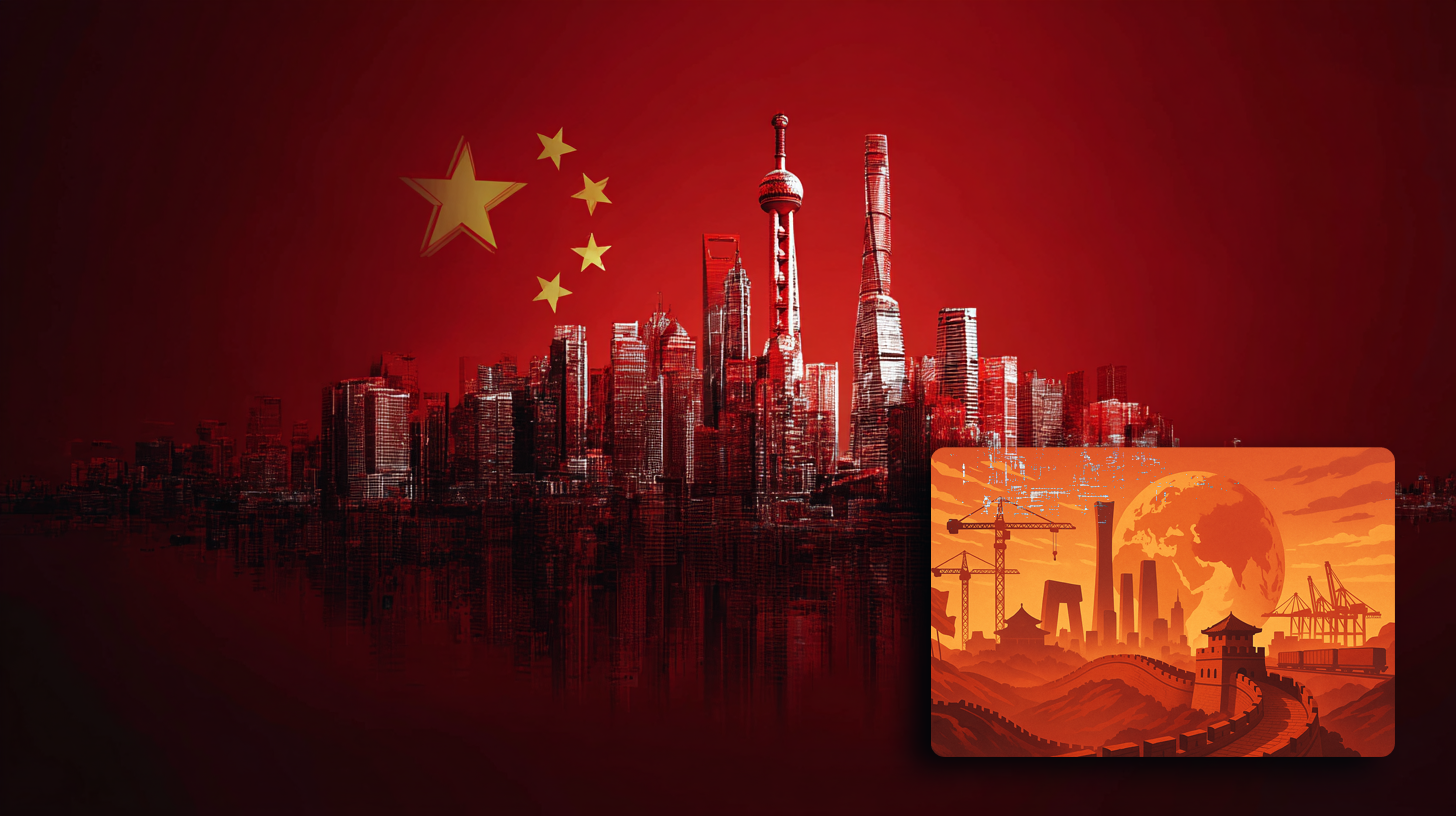
Beijing's new five-year plan and massive investment program: How China is challenging the global economic order – Image: Xpert.Digital
The chip war escalates: Beijing's new five-year plan is a direct challenge to the USA
Current status (October 2025):
The 15th Five-Year Plan (2026-2030) is currently being drafted. The key milestones are:
From October 20 to 24, 2025, the 20th Central Committee of the Communist Party of China (CPC) held its Fourth Plenary Session in Beijing. At this meeting, the Central Committee's proposals for the drafting of the 15th Five-Year Plan (2026-2030) were discussed and adopted. General Secretary Xi Jinping presided over the meeting and presented the draft proposals.
Official farewell
The 15th Five-Year Plan is expected to be officially adopted and implemented by the National People's Congress (China's parliament) in March 2026.
The current 14th Five-Year Plan
The currently valid 14th Five-Year Plan was adopted by the National People's Congress in Beijing in March 2021 and covers the period 2021-2025. It was also initially prepared at a plenary session of the Central Committee in the fall of 2020 and then formally adopted in the spring.
Investment priorities
As early as April 2025, Xi Jinping emphasized the core priorities of the new plan at a symposium in Shanghai, including increased investment in artificial intelligence, semiconductor technology, quantum information technology, and other strategic future technologies. State media launched a nationwide public feedback campaign in March 2025, with "AI Plus" cited as a central topic of discussion.
Suitable for:
- China's "disorderly competition" – The fight against self-destructive economic dynamics (Politburo meeting on July 30, 2025)
Is Beijing upending the rules of the game? Why the new economic order, caught between innovation and systemic conflict, is becoming a litmus test for the West
The new plan is intended to strengthen China's technological self-reliance and make the country less dependent on Western technology supplies – a response to tightened trade restrictions and the technology conflict with the USA.
The next global upheaval has begun: With its new five-year plan and massive investment programs for artificial intelligence, semiconductor technology, and innovative industries, China is redefining the rules of a new economic superpower competition. With this, Beijing is not only responding to technological supply cuts and growing geopolitical tensions with the US and Europe, but is also placing the paradigm shift from cheap mass production to global technological leadership at the center of its national strategy.
This analysis illuminates the structure and dynamics of China's strategic master plan, outlines its historical development, analyzes the driving actors and market mechanisms, examines the current situation using data, illustrates competition using practical country and company case studies, discusses risks and trade-offs, and offers a well-founded outlook on disruptive developments. Finally, it develops strategic options for policymakers and companies.
The Long March to the Top: China's Economic Transformation in Retrospect
China's rise from an isolated developing country to the world's second-largest economy is the result of targeted government management, fundamental reforms, and ambitious phases of industrial expansion. Key milestones included the transition from a planned economy to a market economy in the late 1970s, accelerated by Deng Xiaoping's "reform and opening" policy. Its role as an extended workbench for the Western world was driven by media attention, driven by low labor costs and enormous labor market capacity.
With projects like "Made in China 2025," ambitious investment programs, and, not least, the technological flagship projects in the current five-year plan, the focus is increasingly shifting toward high technology, innovation, and business-oriented research. The dominance in the area of low-cost mass production is thus becoming a springboard for a technology-driven system change, driven as much by internal societal modernization as by geopolitical pressure and increasing isolation from Western markets.
Anatomy of Governance: The Drivers Behind China's Economic Strategy
At the core of the Chinese economic model is the close integration of the party, the state, and key industries. Driven by long-term plans, centralized control instruments, and massively directed investments, the goal is to strengthen the domestic value chain, minimize dependence on Western technology suppliers, and expand global market power. In addition to key political and administrative actors (National Development and Reform Commission, ministries), large state-owned enterprises and private digital and technology corporations are at the center of the transformation agenda.
Economic drivers are:
- Targeted government funding in future sectors (AI, semiconductors, renewable energies)
- Strict industrial policy and subsidies for 'national champions'
- Economies of scale in the internal market through over one billion consumers
- Massive state control of capital flows and investments in research and development
The complex control logic is complemented by incentives, restrictions, and technology policy programs such as the Social Credit System. At the same time, however, the expectations and demands of a digitally connected, growing middle class are rising, increasingly demanding high-quality innovations rather than low-priced products.
Our China expertise in business development, sales and marketing
Industry focus: B2B, digitalization (from AI to XR), mechanical engineering, logistics, renewable energies and industry
More about it here:
A topic hub with insights and expertise:
- Knowledge platform on the global and regional economy, innovation and industry-specific trends
- Collection of analyses, impulses and background information from our focus areas
- A place for expertise and information on current developments in business and technology
- Topic hub for companies that want to learn about markets, digitalization and industry innovations
Semiconductor three-way battle: USA, China and Taiwan in the race for chips
Data and diagnoses: China's economic transformation in the fact check
The profound structural change is reflected in a number of striking indicators:
- The share of knowledge-based industries and high technology has been rising continuously for years, while traditional textile and metal industries are shrinking.
- GDP growth has slowed significantly after decades of boom, but was still around 5 percent recently, while Western countries stagnated or experienced recession.
- China invested over $1.4 trillion in strategic industries such as semiconductors, electric vehicles, AI, and quantum computing between 2020 and 2025 alone.
- In the semiconductor sector, government and private investments have increased by more than 30 percent annually over the past five years.
- Exports of high-tech products already accounted for around 33 percent of total Chinese exports in 2024.
At the same time, many industries are struggling with overcapacity, debt problems, and demographic change. Youth unemployment is at record levels, and the real estate crisis regularly causes uncertainty in the financial markets. Economic inequality between the megacities on the east coast and the inland provinces also remains glaring.
Suitable for:
A three-way battle for the future: The semiconductor strategies of the USA, China and Taiwan
A vivid comparison can be drawn in the technology sector between China, the USA, and Taiwan, particularly with regard to the semiconductor market. While the USA, with companies like Intel, Nvidia, and AMD, has shaped international development for decades, Taiwan, with TSMC, dominates the high-precision manufacturing of cutting-edge microchips.
China, in turn, supported by massive government subsidy programs, is pooling enormous resources to establish national champions like SMIC and YMTC as alternatives to the Western-dominated chip ecosystem. While China's market share in cutting-edge technologies for processors and memory modules still lags behind, it is increasingly succeeding in narrowing technological gaps through state-orchestrated innovation efforts. This is evident, for example, in the supercomputer breakthrough or the rapid progress in AI applications.
Strengths of the USA: Market leadership in research and development, culture of innovation, qualified workforce, and globally networked venture capital.
China's strengths: Long-term government control, financial clout, huge economies of scale in the domestic market, strategic control over key resources, and rapidly scalable implementation capabilities.
Taiwan's role: Technological pacesetter in the field of the most advanced chip manufacturing, but geopolitically highly vulnerable and positioned between the power blocs.
Results: While the US remains the innovation leader, China is rapidly closing the gap in scaling and domestic adoption. Taiwan maintains its technological leadership – but remains vulnerable to geopolitical risks.
The other side of the coin: conflicting objectives and systemic threats on China's path
The dangerous balancing act between rapid progress, efforts toward self-sufficiency, and the threat of market overheating is itself part of the new economic normal. The key risks are:
High levels of debt among state-owned enterprises and regions, coupled with opaque credit markets.
Growing technology and export controls in the West, which could create supply gaps despite national substitution efforts.
Systemic risks from the rapid expansion of AI, for example in the protection of intellectual property, the control of algorithmic decisions or in issues of digital surveillance.
Social disparities between winners and losers of rapid change, exacerbated by urbanization and labor market distortions.
The academic debate is controversial: While proponents point to the innovative power of focused industrial policy, critics warn of the consequences of excessive subsidies and market distortions. Conflicts between security interests and an open innovation culture, between self-sufficiency and the global division of labor, and between growth and sustainability remain salient.
The world of tomorrow: Three possible futures in the competition of systems
Given the current dynamics, long-term developments are difficult to predict with any certainty. However, the following scenarios appear plausible:
Scenario 1
China achieves a technological breakthrough – the domestic market and government support mechanisms prevail, Chinese companies become global benchmarks and export their standards.
Scenario 2
Multipolar fragmentation – The global supply chain is permanently splitting into Western and Chinese-dominated spheres, innovations are increasingly running parallel, and competitive pressure is increasing worldwide.
Scenario 3
Systemic setback – Debt crises, demographics, and political mismanagement are slowing China's ambitions, while the West is defending its technological leadership through new coalitions and innovation alliances.
In summary, geopolitical disruptions – from supply chain wars to sanctions to military escalation, for example in Taiwan – could force radical course corrections at any time.
What needs to be done now: Strategic answers for politics and companies
The balance of power between China and the West will be decisively shaped by innovation capacity, systemic resilience, and the capacity for strategic change. States and companies are called upon to
pool capacities for continuous innovation development and risk management, reduce dependencies, and invest in strategically relevant technologies. If the West persists with short-term reactions and patchwork solutions, there is a risk of technological lag.
Successfully managing China's economic strategy requires a willingness to engage in complex alliances, pursue proprietary industrial policy programs, promote targeted talent development, and consistently safeguard critical infrastructure. In the new global economic order, the ability to manage the game will determine the rules of the game—no longer just the free market alone.
Your global marketing and business development partner
☑️ Our business language is English or German
☑️ NEW: Correspondence in your national language!
I would be happy to serve you and my team as a personal advisor.
You can contact me by filling out the contact form or simply call me on +49 89 89 674 804 (Munich) . My email address is: wolfenstein ∂ xpert.digital
I'm looking forward to our joint project.
☑️ SME support in strategy, consulting, planning and implementation
☑️ Creation or realignment of the digital strategy and digitalization
☑️ Expansion and optimization of international sales processes
☑️ Global & Digital B2B trading platforms
☑️ Pioneer Business Development / Marketing / PR / Trade Fairs
🎯🎯🎯 Benefit from Xpert.Digital's extensive, five-fold expertise in a comprehensive service package | BD, R&D, XR, PR & Digital Visibility Optimization
Benefit from Xpert.Digital's extensive, fivefold expertise in a comprehensive service package | R&D, XR, PR & Digital Visibility Optimization - Image: Xpert.Digital
Xpert.Digital has in-depth knowledge of various industries. This allows us to develop tailor-made strategies that are tailored precisely to the requirements and challenges of your specific market segment. By continually analyzing market trends and following industry developments, we can act with foresight and offer innovative solutions. Through the combination of experience and knowledge, we generate added value and give our customers a decisive competitive advantage.
More about it here:

